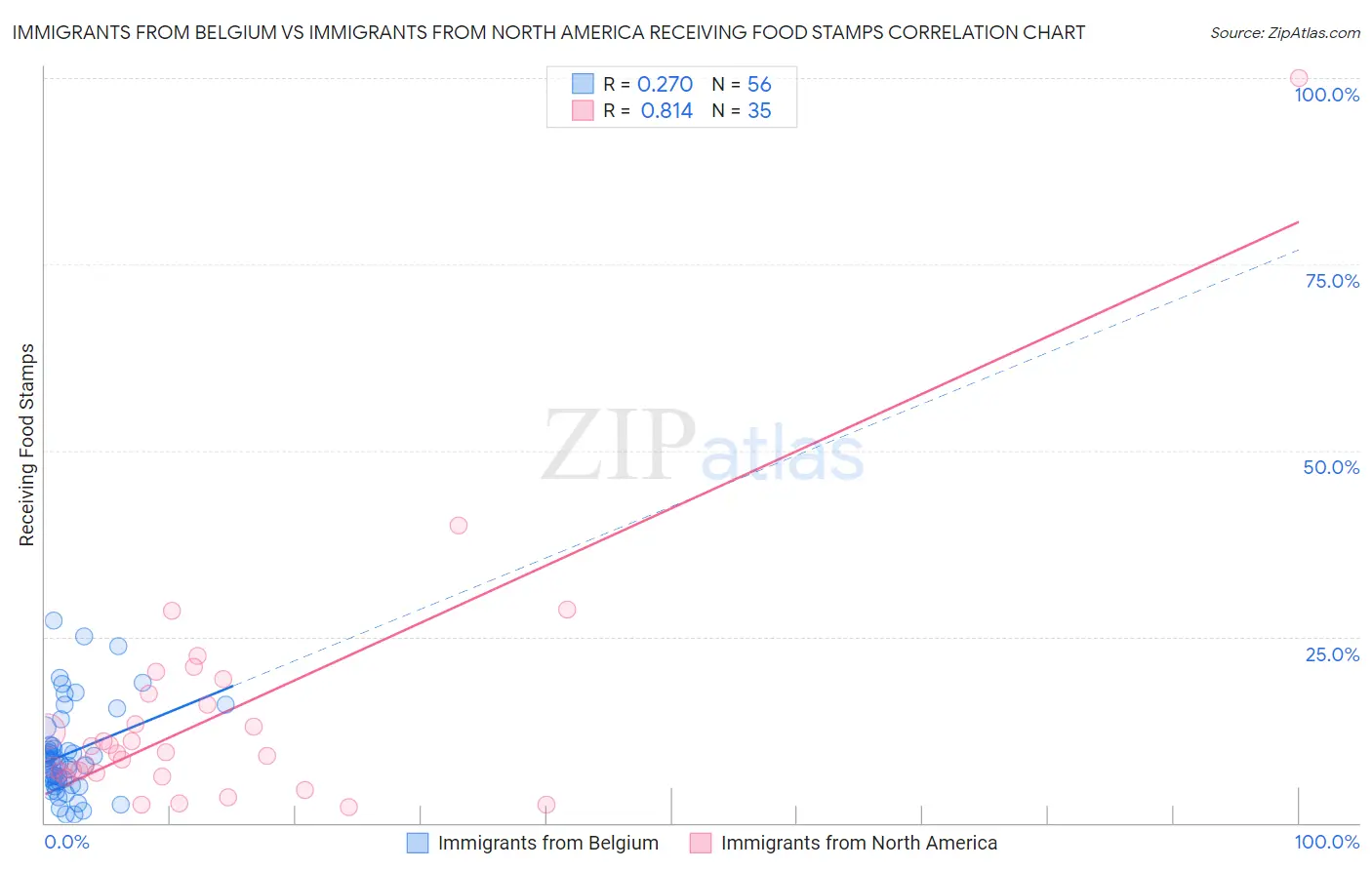Immigrants from Belgium vs Immigrants from North America Receiving Food Stamps
COMPARE
Immigrants from Belgium
Immigrants from North America
Receiving Food Stamps
Receiving Food Stamps Comparison
Immigrants from Belgium
Immigrants from North America
9.6%
RECEIVING FOOD STAMPS
99.4/ 100
METRIC RATING
45th/ 347
METRIC RANK
9.8%
RECEIVING FOOD STAMPS
99.2/ 100
METRIC RATING
64th/ 347
METRIC RANK
Immigrants from Belgium vs Immigrants from North America Receiving Food Stamps Correlation Chart
The statistical analysis conducted on geographies consisting of 146,482,821 people shows a weak positive correlation between the proportion of Immigrants from Belgium and percentage of population receiving government assistance and/or food stamps in the United States with a correlation coefficient (R) of 0.270 and weighted average of 9.6%. Similarly, the statistical analysis conducted on geographies consisting of 460,673,345 people shows a very strong positive correlation between the proportion of Immigrants from North America and percentage of population receiving government assistance and/or food stamps in the United States with a correlation coefficient (R) of 0.814 and weighted average of 9.8%, a difference of 1.7%.

Receiving Food Stamps Correlation Summary
| Measurement | Immigrants from Belgium | Immigrants from North America |
| Minimum | 1.1% | 2.1% |
| Maximum | 27.1% | 100.0% |
| Range | 26.0% | 97.9% |
| Mean | 9.3% | 14.4% |
| Median | 8.0% | 9.6% |
| Interquartile 25% (IQ1) | 5.5% | 6.7% |
| Interquartile 75% (IQ3) | 10.4% | 17.4% |
| Interquartile Range (IQR) | 4.9% | 10.7% |
| Standard Deviation (Sample) | 6.0% | 17.1% |
| Standard Deviation (Population) | 5.9% | 16.9% |
Demographics Similar to Immigrants from Belgium and Immigrants from North America by Receiving Food Stamps
In terms of receiving food stamps, the demographic groups most similar to Immigrants from Belgium are Immigrants from Denmark (9.6%, a difference of 0.030%), Australian (9.6%, a difference of 0.080%), Indian (Asian) (9.6%, a difference of 0.15%), Russian (9.6%, a difference of 0.25%), and Immigrants from Czechoslovakia (9.6%, a difference of 0.27%). Similarly, the demographic groups most similar to Immigrants from North America are Chinese (9.8%, a difference of 0.090%), Immigrants from Bulgaria (9.8%, a difference of 0.12%), English (9.8%, a difference of 0.19%), German (9.7%, a difference of 0.34%), and British (9.7%, a difference of 0.43%).
| Demographics | Rating | Rank | Receiving Food Stamps |
| Immigrants | Denmark | 99.4 /100 | #44 | Exceptional 9.6% |
| Immigrants | Belgium | 99.4 /100 | #45 | Exceptional 9.6% |
| Australians | 99.4 /100 | #46 | Exceptional 9.6% |
| Indians (Asian) | 99.4 /100 | #47 | Exceptional 9.6% |
| Russians | 99.4 /100 | #48 | Exceptional 9.6% |
| Immigrants | Czechoslovakia | 99.4 /100 | #49 | Exceptional 9.6% |
| Lithuanians | 99.4 /100 | #50 | Exceptional 9.7% |
| Asians | 99.3 /100 | #51 | Exceptional 9.7% |
| Immigrants | South Africa | 99.3 /100 | #52 | Exceptional 9.7% |
| Tongans | 99.3 /100 | #53 | Exceptional 9.7% |
| Swiss | 99.3 /100 | #54 | Exceptional 9.7% |
| Immigrants | Switzerland | 99.3 /100 | #55 | Exceptional 9.7% |
| Immigrants | Canada | 99.3 /100 | #56 | Exceptional 9.7% |
| Greeks | 99.3 /100 | #57 | Exceptional 9.7% |
| Scandinavians | 99.2 /100 | #58 | Exceptional 9.7% |
| British | 99.2 /100 | #59 | Exceptional 9.7% |
| Germans | 99.2 /100 | #60 | Exceptional 9.7% |
| English | 99.2 /100 | #61 | Exceptional 9.8% |
| Immigrants | Bulgaria | 99.2 /100 | #62 | Exceptional 9.8% |
| Chinese | 99.2 /100 | #63 | Exceptional 9.8% |
| Immigrants | North America | 99.2 /100 | #64 | Exceptional 9.8% |